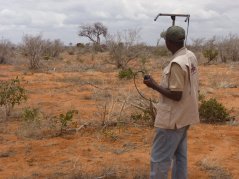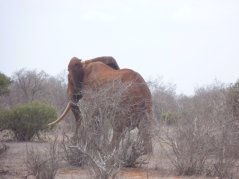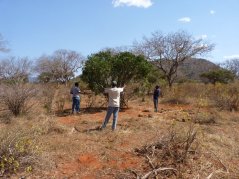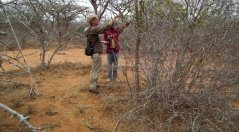
Project
Elephant survival in the drylands
Yussuf Wato uses telemetry and birth and death data to understand how temporal variability of rainfall and spatial heterogeneity of food and water affect the population dynamics of elephants in Kenya.
Project description
Large mammals in natural ecosystems are assumed to be regulated by density-dependent factors if processes are governed by equilibrium conditions. In such equilibrium systems, the vegetation would ultimately attain a sort of “climax stage”, and with a stable food resource, it is expected that herbivore populations will persist at a density set by the habitat’s ability to support them. However, in ecosystems with very high year-to-year and seasonal precipitation variability, forage availability varies to such a great degree that herbivore population dynamics are driven by rainfall via its direct effect on forage availability in any given year. In these non-equilibrium systems, density-dependent interactions such as competition for resources play a minor role in regulating populations. To date, analyses of factors that drive African elephant populations has not been conclusive, with both density dependent and density independent processes reported to regulate or control, respectively, populations at different locations.
Further, in most arid and semi-arid ecosystems, an increase in the frequency of drought and reduction in the average annual rainfall has been reported or suggested in the past decades. Climate-population dynamics are little understood, especially the specific demographic attributes that are affected, if any. In this study, my aim is to contribute to this knowledge gap by investigating the long term impact of temporal rainfall variability, spatial resource heterogeneity and its role in elephant population dynamics. I will collect data through retrieving previous tracks from GPS collared elephant herds, field vegetation surveys and time series, and spatially explicit elephant mortality and census data. I posit that frequent droughts and low annual rainfall reduce food and water availability for elephant, thus leading to increased elephant mortality and affecting elephant dispersal patterns. This phenomenon is expected to play an important role in influencing long term elephant population dynamics in semi-arid systems, in contrast to the situation in which density dependency is thought to be overriding.
My study will contribute to the understanding of the role of abiotic factors (frequency, length and severity of droughts) in elephant population dynamics. It will also have an important implication for the conservation of elephant, since culling would be less of an issue under the drought scenario since individual elephant have an increased chance of dying during a drought anyway.



